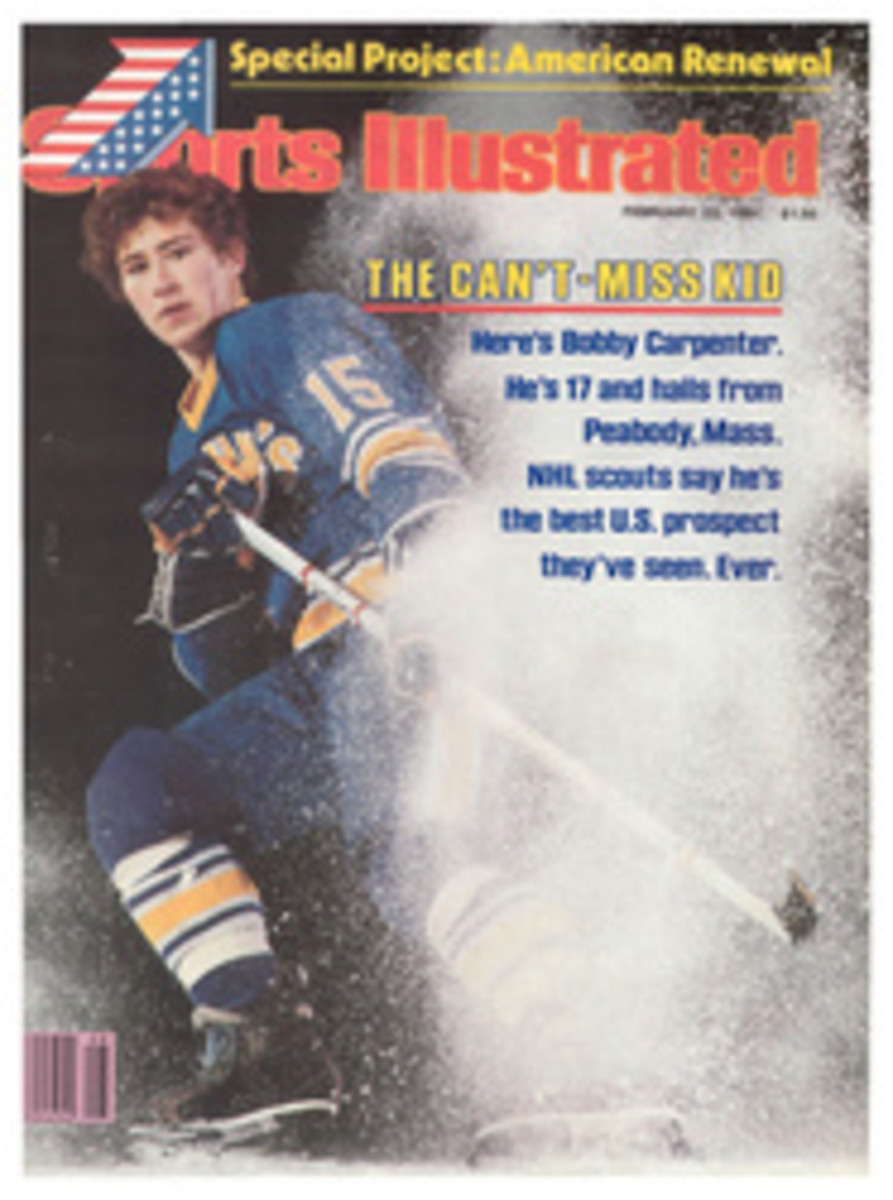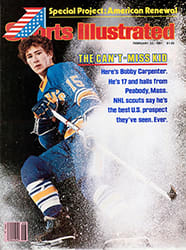
HATS OFF TO THE KING
Even though he had won the Daytona 500 six times in his 22-year career and no one else had won it more than twice, it was something of a surprise to see Richard Petty in Victory Circle Sunday afternoon following the 23rd running of NASCAR's premier race. Most unpleasantly surprised of the 100,000 people on hand was Bobby Allison, who had figured, along with virtually everyone else, that all he had to do to get there was to stay away from trouble and run good. Allison's Pontiac had been fastest in practice, fastest in time trials (194.624 mph), first in a qualifying race, fastest for 174 laps of the main event's 200 laps. Indeed, fastest so easily that in the middle of the race fellow driver Darrell Waltrip had said, "Bobby's just playing with the guys."
Well, 43-year-old Richard Petty beat Allison to the finish line by four seconds, and Bobby had run real good. But King Richard had run a little smarter. As Allison sat dejected on his workbench back in the garage, it was almost with mordant satisfaction that he said, "Looks like Petty was just playing with the guys. Everybody was accusing me of sandbagging all week; well, they better look for someone else now—the No. 1 sandbagger of all time."
"It wasn't particularly sandbagging." said Petty. "We was just sort of waiting for an opportunity and when it came we took advantage of it." And that was as good a definition of sandbagging as any.
After the drivers had spent almost a decade and a half learning all the speed secrets of "full-size" cars, NASCAR up and mandated that "down-sized" American cars be used in its major racing division this year, simply because Detroit is making more of them. These cars have a wheelbase of 110 inches, five inches shorter than their predecessors. But five inches may as well be a mile when building a racing car, and there had been worry that the shorter cars would be less stable. Daytona being the first race under the new specs—and its high-banked. 2.5-mile, tri-oval configuration being the most demanding track on the circuit—trouble could come quickly.
It did. The new cars immediately made their mark in history as the most squirrelly ever to be dropped on a superspeedway.
"Loose" is a stock car term that describes a car whose rear end slides a lot, and the new cars were so loose that if they were people they would've been double-jointed. Horror stories of 190-mph slides spread through the garages. Waltrip said racing a downsized car was like motoring with flat tires at 70 mph on a crowded freeway. His crew told him they would point a gun at his head to get him in the driver's seat if they had to. "And if you come back before practice is over, we're gonna shoot," they said as he pulled away.
Something was causing the rear ends of the cars to get light; one mechanic swore he could see daylight under Cale Yarborough's rear tires as he came off Turn 4. "You know, a damn airplane only has to be going 50 mph to take off, and these cars are going 190," said David Ifft, Yarborough's crew chief.
Evidence as to the cause of the problem seemed to point to the new cars' square rooflines. Instead of allowing air to flow down over the trunks, as was the case with the older cars—all of which had sloping rear windows—the wind shot straight back off the roof, creating a vacuum over the trunk that sucked the car upward. Also, there is more side-window area in the new generation of cars, and at 190 mph air would rush into the driver's compartment, only to be damned up against the rear window and actually push up on the roof of the car. Aerodynamically, they were "accidents waiting to happen," A.J. Foyt grumbled.
It wasn't a long wait. In Thursday's first 125-mile qualifying race a strong wind was blowing, and two cars flipped in the weirdest—and scariest—pair of crashes many drivers had ever seen. The cars, driven by John Anderson and Connie Saylor (both of whom walked away from their wrecks), first spun out, then, while still sliding, soared into the air upside down, as if they had been yanked up by a giant sky hook.
Waltrip, who won the second qualifier in his Buick Regal, watched one of the flips on closed-circuit TV. "You see that car coming off the ground?" he shouted. "They ain't supposed to do that! Those suckers weigh 3,700 pounds!"
Though Petty's STP Buick Regal was handling better than most of the other cars—thanks to his cousin Dale Inman, who is in charge of tuning the chassis—only Allison had been untroubled by a fear of flying. Allison had shown up at Daytona with a sloped-roof Pontiac Le-Mans, a car doomed to be discontinued by GM after 1981. It proved to be the fastest dinosaur on wheels, as Allison easily won the first qualifying race.
Racing the LeMans was the idea of Allison's crew chief, Waddell Wilson. They had tested a square-roofed Oldsmobile Cutlass, but decided the design had serious problems. So they secretly built the LeMans: 12 men working 11½ hours a day, seven days a week since mid-November, with only Christmas off. They painted it black and silver, named it the Silver Streak and went to Daytona.
Then they wheeled it off the trailer. "What's this?" the other crews shouted. "A sloped roof? That's not fair! NASCAR told us there would be no sloped-roof cars this year."
Allison made a few hot laps, came back smiling and said. "Loose? You mean you guys are loose?" The controversy was on. Daytona wouldn't be Daytona without one; nor would it be so much fun.
Most of the teams thought the whole deal was fishy; they felt set up by NASCAR, and many were mad. Said Junior Johnson, owner of Waltrip's Buick, "NASCAR advised a lot of people not to build a LeMans." Other crews went further; some even accused Dick Beaty, NASCAR's chief inspector, of having told them that slope-roofed cars wouldn't be legal, though the LeMans was clearly on the eligibility list.
Waddell Wilson had an answer. "The guys are all surprised that we had a LeMans. I'm surprised that they don't have one. I'll tell you what I think. I think they were all looking at the front ends, which look good. I don't think they even once looked at the rear ends. And monkey-see, monkey-do, which is why they all have square roofs."
Not everyone begrudged Wilson his coupe. Said Inman, "Maybe Waddell just did his homework. I sure wouldn't mind being the only LeMans out here."
Eventually, NASCAR officials, bowing to pressure from all its stars except Allison—and the sight of cars spinning and flipping—allowed larger rear spoilers to go on the cars. They would increase downforce on the rear tires, but after a brief testing session, many drivers were not convinced the problem was anywhere near solved.
Even Allison was skeptical. "It's going to take a great deal of professionalism to keep all those cars going in the same direction," he said, though one couldn't help feeling that Allison was worrying more about the direction of other cars than his own.
There is a great deal of professionalism among NASCAR drivers when they get behind the wheel, and despite the squirrelly cars and 40-mph wind, the 500 was fast, clean and safe. It was a typical NASCAR race for those first 174 laps, with 49 lead changes among nine drivers. Allison led for 90 laps, seriously challenged only by his protègè, Neil Bonnett, who was driving the Wood Brothers Thunderbird. But Bonnett had tire trouble, and the resulting vibration bounced his car to death. He finally retired on Lap 123. Waltrip. Foyt and David Pearson suffered blown engines; Yarborough was taken out of the hunt by a cut tire. Allison was left with what looked like a clear advantage over Petty and the rest of the strong survivors: Ricky Rudd, Buddy Baker and Dale Earnhardt, who would finish third, fourth and fifth, respectively.
On the 174th lap the sand in the bag shifted. Allison ran out of gas on the backstretch. Having led 32 of the previous 40 laps, he had used more than his crew figured, because leading uses more gas than following. It was Allison's only mistake. He coasted onto pit row as Rudd. Baker and Earnhardt sped by on their way into the pits for their final stops. Allison's crew changed right-side tires and dumped in two cans of gas, the same drill the others performed, costing each between 16 to 22 seconds. Inman watched Allison's stop and knew this was Petty's opportunity: when Richard blasted into the pits two laps later, his crew skipped the tire change and added just one quick can of gas. Total time in the pit: 6.8 seconds. Petty pulled out on the track with a lead of 10 seconds on Allison, and the STP crew held its breath.
Everybody thought Allison would be able to run him down, but Petty found more speed somewhere and hung on. That Petty could do so caused Allison to suggest Petty's speed had come out of his sandbag.
"I didn't outsmart them," said Petty. "I ran as hard as I could all day. Dale and the crew—they outsmarted 'em. They knew the tires would make it, and they knew how far we could go on a can of gas." Exactly how far, in fact—Petty's Buick coughed, nearly out of gas. crossing the finish line. "It was a follow-the-leader deal," said Richard, referring to that last pit stop, "and the deal was we didn't follow."
It was Waddell Wilson who said early in the week that monkey-see, monkey-do was what got the other crews in trouble. But in the end it was monkey-see, monkey-don't-do that won it for Petty.
PHOTO
PHOTO
Connie Saylor's Olds spun in a qualifying race.
PHOTO
Then, somersaulting out of Turn 2, Saylor stood on his nose as Ronnie Sanders safely drove past.
PHOTO
The Olds snap-rolled back to earth on its roof.
PHOTO
Finally it skidded down the back straight, leaving a long trail of flame. Miraculously, Saylor was unhurt.

